An Exhibition of Art Projects by FIT Students for Reflections on Realities of Labor, Equity, and Social Justice.
Dates: January 31 to May 24, 2024
Location: Fifth Floor, Gladys Marcus Library, Fashion Institute of Technology
This exhibition is to showcase how the fashion industry is intertwined with labor history of the United States. This is related to a three-year research project of teaching labor history to art and design students funded by the National Endowment for the Humanities Education Grants (PI: Kyunghee Pyun; Co PIs: Vincent Quan and Rebecca Bauman). Professor Susanne Goetz in Textile and Surface Design, Professor Su Ku in Fashion Design, Professor Subh Gooptu in English and Communication Studies collected students’ projects related to the theme of labor history in their classes. Some are written essays while some are idea sketches along with sewn examples. Relevant books in the library are also displayed with presentations by FIT students.
Curator: Kyunghee Pyun, History of Art
Curatorial Assistant: Sally Li, Textile Development and Marketing
Graphic Designer: Jungmin Hur, Illustration
Exhibitions photos by Savannah Shack De La Cruz
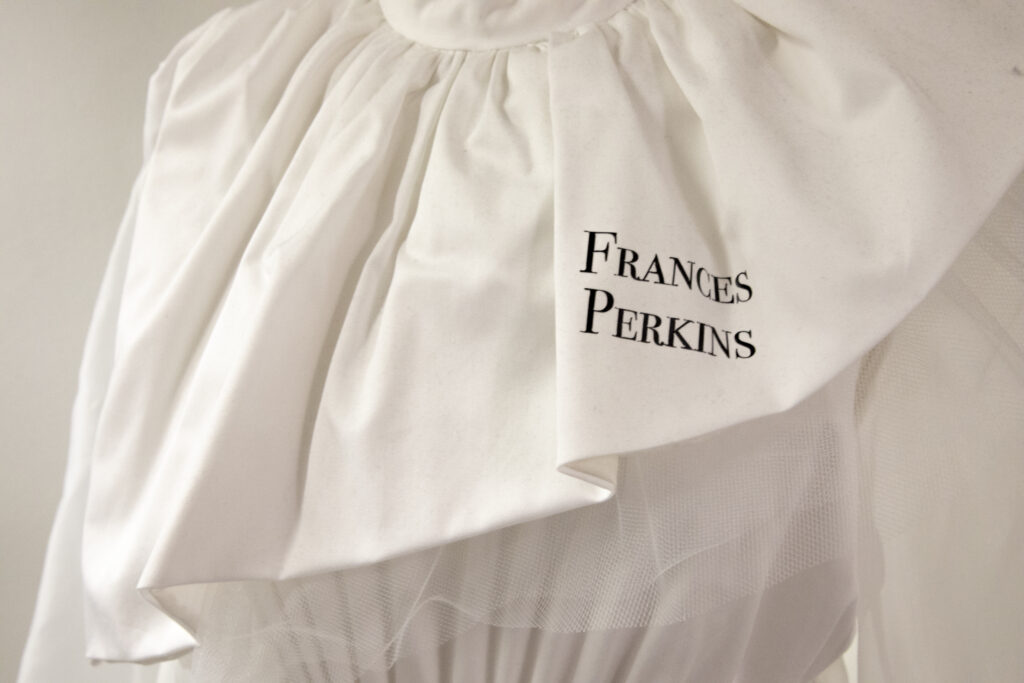
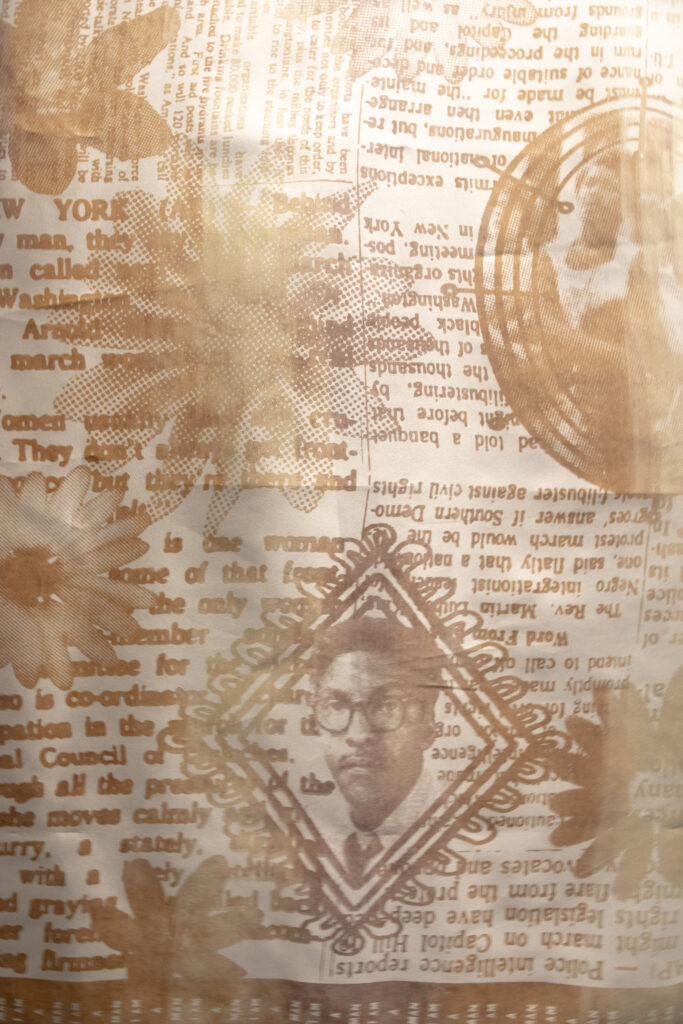

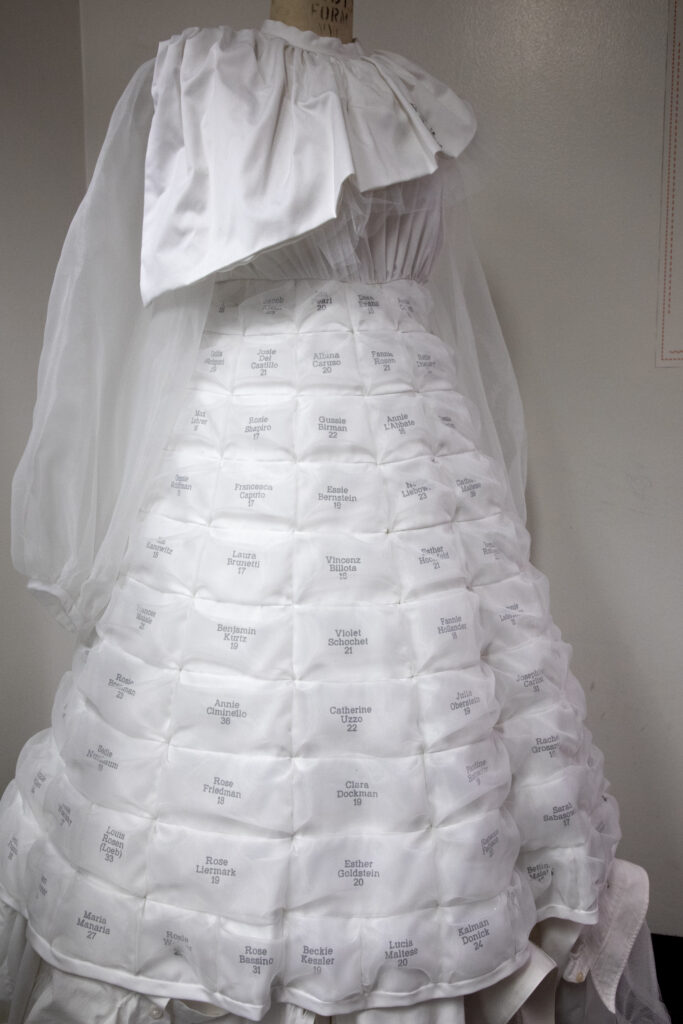
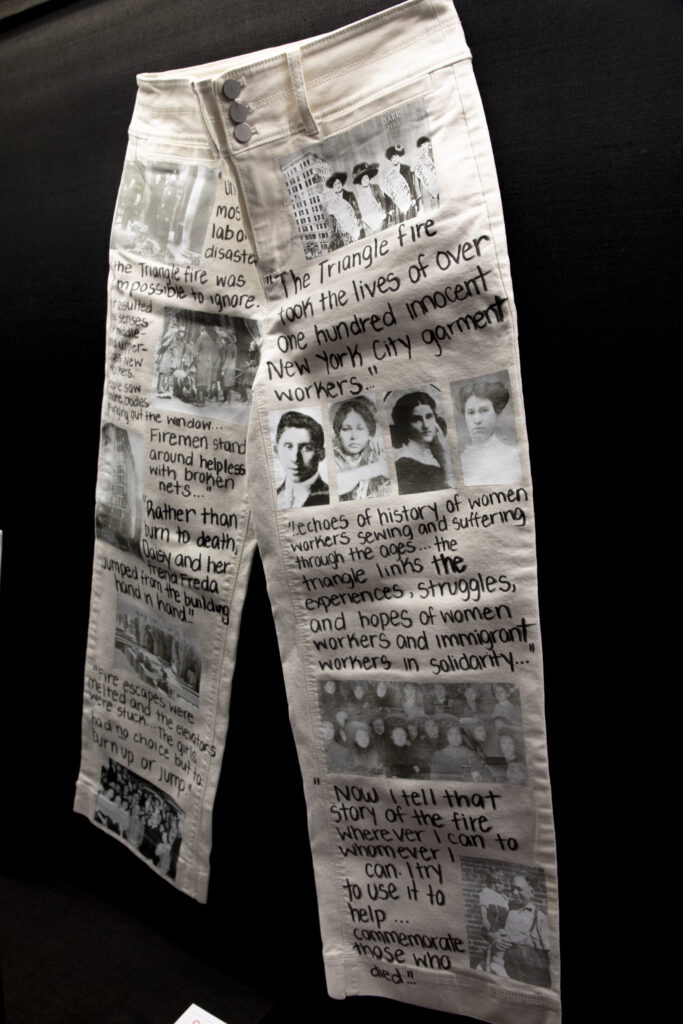
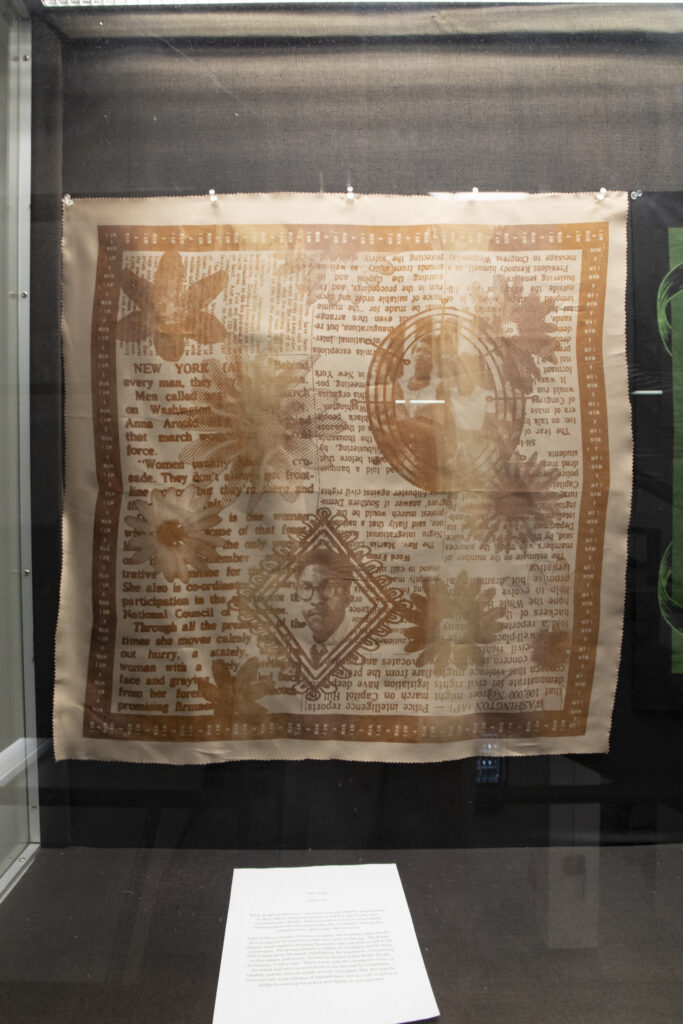
Commemorative Scarf: The March on Washington for Jobs and Freedom
By Professor Susanne Goetz and her students
These works were created in my class, TD 361- Screen Printing Scarves, in the department of Textile and Surface Design in the fall semester of 2023. Below is the instruction for assignments.
Create a one-color screen printed scarf that commemorates the March on Washington for Jobs
and Freedom. The scarf should be visually appealing and meaningful, and it should reflect what
is important to you about the March on Washington. The March on Washington for Jobs and Freedom, also known as simply the March on Washington or the Great March on Washington, was held in Washington, D.C., on August 28, 1963.
Considerations:
What images or symbols represent the March on Washington for you?
What message do you want to convey with your scarf?
What colors and patterns would you like to use?
How will you use screen printing techniques to create your design?
Research:
Learn about the history of the March on Washington and the Civil Rights Movement.
Look at other screen printed scarves and other works of art that commemorate
the March on Washington.
Experiment with different screen printing techniques and materials.
I gave a lecture on the history commemorative scarves and the class watched a brief video on
the March on Washington. Students read a transcript of Martin Luther King’s speech.
Dan Levinson Wilk and Molly Schoen from the History of Art department came to class and
spoke about the research initiative The 1863 · 1963 · 2023 Project: Civil Rights in FIT’s
Neighborhood, specifically about the 1963 the March on Washington and FIT’s connections to
the event.
We discussed students’ takeaways from their reading of MLK’s speech and ideas how designs
could commemorate the event.
Students had several class sessions to develop and execute their design ideas and wrote an
artist’s statement about their heir work. Work of all students was exhibited in a large department showcase.
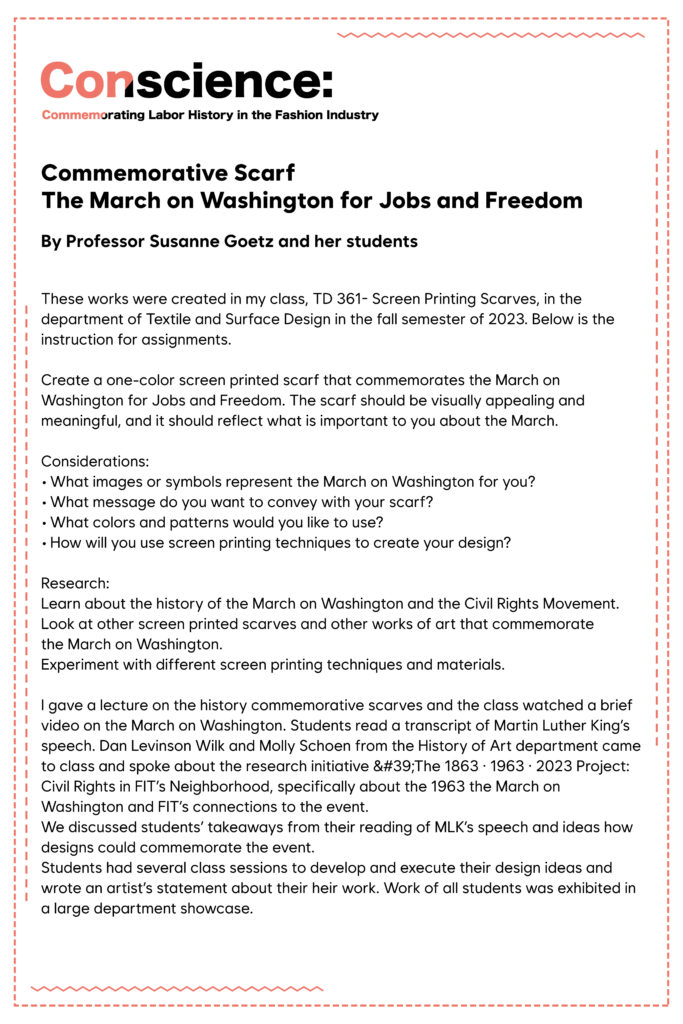
Literacy is Liberation: Reflections on Learning about Women’s Labor through History and Literature
By Professor Subh Gooptu and her students
These student works were created in my EN 335 Working Women in the US class for a group project focused on public literacy and knowledge of New York’s labor history, specifically of the Triangle Factory Fire (1911), in conversation with other contemporary events related to labor conditions in the global fashion and garment industry.
Students examined scholarly and journalistic writing about women’s labor conditions in NY and elsewhere in the world, and created an informational product that drew connections between the 1911 Triangle Factory Fire and similar tragedies around the world. Then, students interviewed a professional member of the fashion, design and art industry in NY to discuss their literacy journeys regarding women’s labor history. They reported their experience with research, creative design of the product and the interview in a Project Reflection Statement, where they considered:
- Where do professionals learn about women’s labor histories, especially tragedies, political organizing and social movements? Through traditional news, social media or online, family stories?
- What would they like to know more about? And according to them, what is the best way to educate/inform other members of the industry about these histories?
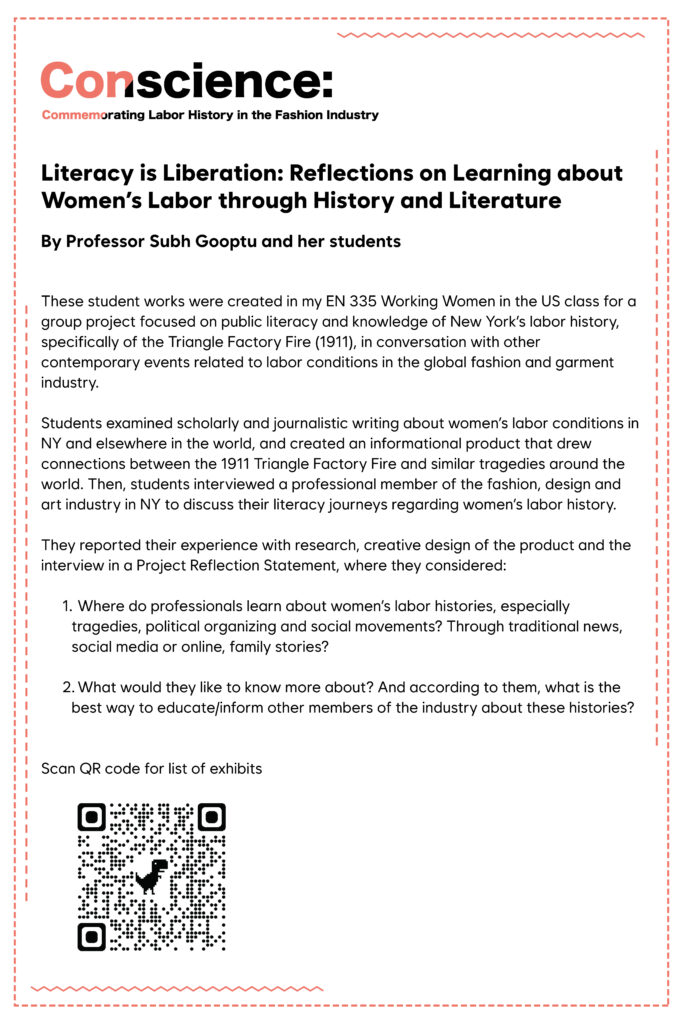
Consciousness
By Professor Su Ku and her students: Glen Roh, Asalya Samieva, and Sally Li
Three students taking Professor Su Ku’s class participated in designing a dress to commemorate the Triangle Shirtwaist Factory Fire on Saturday, March 25, 1911. The factory was located in the Brown Building at 23 Washington Place, which is now part of the campus of New York University. Originally the building was called Asch Building. The factory was on the eighth, ninth, and tenth floors. About 146 people died: 123 women and girls and 23 men. Students used upcycled shirts and created a dress with
names of victims.
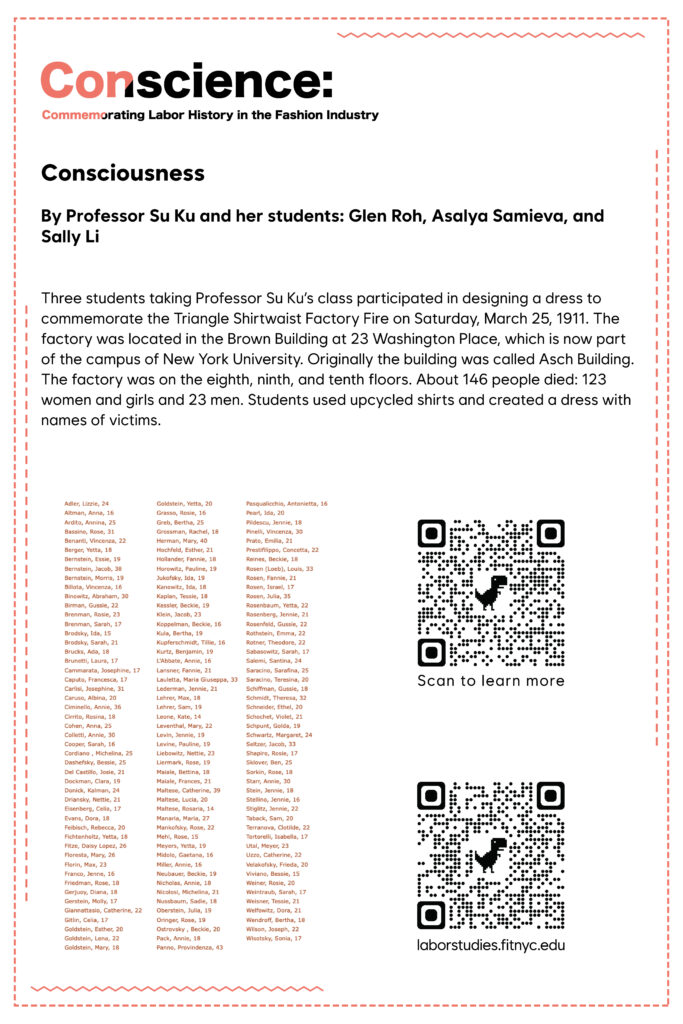
Project by Adrianna Valenta, Leizli Ramirez Rojas, Kathlyn Huynh, Amanda Vingara
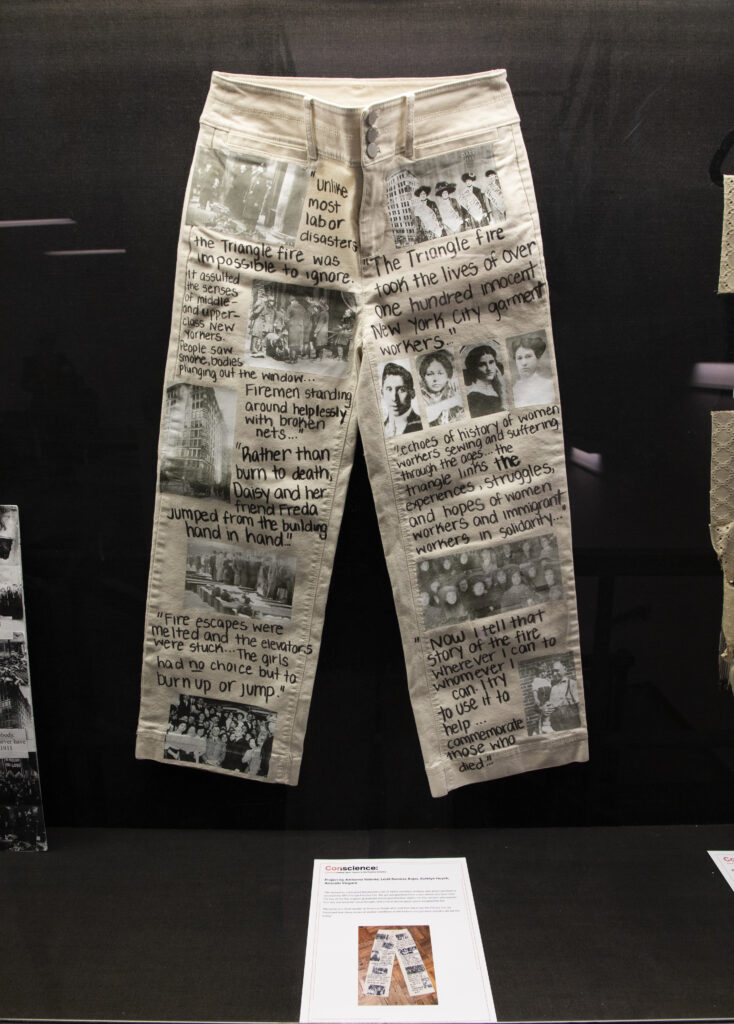
“We wanted to understand the perspectives of family members of those who either perished or survived the 1911 Triangle Factory Fire. We got perspectives from a son, whose dad was there the day of the fire, a great-grandchild whose grandmother died in the fire, an aunt who passed that day and what her niece thought, and a niece whose great-uncle escaped the fire. We spoke to a retail worker at American Eagle who said that she knew this history, but we discussed how these issues of worker conditions in the fashion and garment industry still persist today.”
Project by Emma Connolly, Christina Leung, and Samantha Bennardo
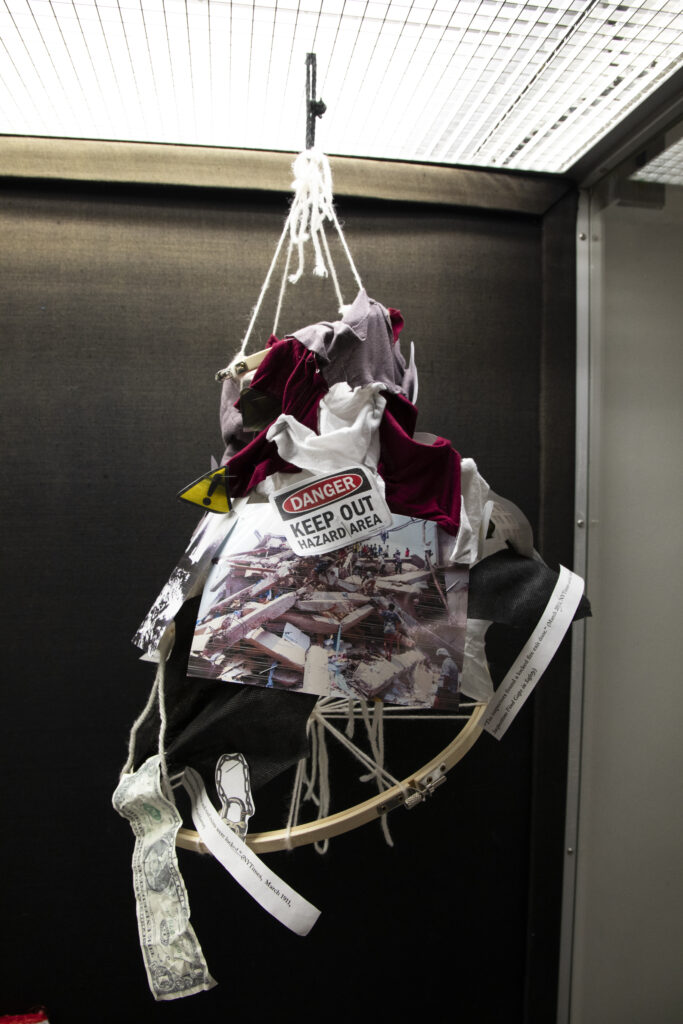
“We chose the medium of a tiered mobile containing text, photographs, and textiles to convey the overarching theme of— issues plaguing labor conditions; with a focus on the Triangle Shirtwaist Factory Fire (1911) and the sweatshop fire in Rana Plaza (2013) in Bangladesh.To convey this chosen central theme, we decided to create a chandelier model with 3 tiers filled with quotes, images from the fire (buildings, survivors), distressed fake money and fabric. Each tier will represent something different. The bottom and largest ring will be corporate corruption. The middle ring will be survivors/people silenced and locks. Finally the top ring will be safety violations and hazard signs. The three rings of the chandelier portray each of these ideas, with the bottom ring being the largest to display the overall underlying issues in the industry. The middle ring represents the voices of survivors which were silenced in the media and therefore hidden between the two other rings in the chandelier. The locks represent the voices that were locked away, hidden from the public. Lastly, the third ring represents the safety violations that the factory owners committed. We chose to share our project with a marketing and production intern at Marc Jacobs. She was extremely moved by the imagery and visuals. She expressed how she was shocked at the severity of these incidents, and how “history quite literally repeated itself.” After our discussion, Lauren commented how she strongly thinks that learning of events like these should be a mandatory requirement in our education, at FIT, as we are the future leaders of the fashion Industry.”
Project by Katherine O’Brien, Fallon McKnight, & Sandy Vidals
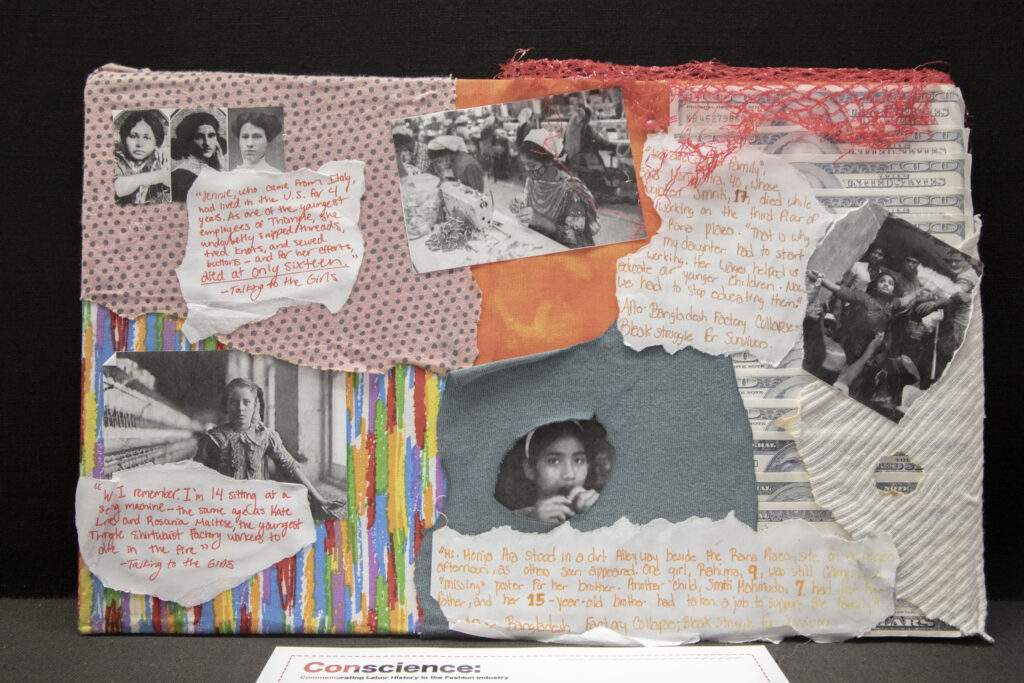
In researching the Triangle Shirtwaist Fire in New York and the Collapse of Rana Plaza
in Bangladesh, we were all shocked by and drawn to the stories pertaining to the younger victims
of these tragedies. We decided to create a collage honoring and representing the young lives lost
because we wanted viewers to understand the severe consequences of poor working conditions,
We included fabric scraps to represent their countless hours devoted to the demanding garment industry, as well as money to represent the profit the factory owners received in insurance money from the victims’ deaths and their lack of Repercussions. We showed a picture of the project to an alumni from FIT who currently works for Ross Dress for Less. He had heard about the Triangle Shirtwaist Fire previously through classes at FIT. He was also familiar with the Bangladesh fire, again from a class at FIT, and what he remembers is this fire was even worse than what happened in New York, especially because it happened much more recently. He expressed disgust at the lack of knowledge most consumers have about the clothes they buy and where they’re produced. He recommended that education about the fires should be mandatory in all training videos to hammer home how important safety is in these factories, safety that should come before profit in the fashion industry.
Project by Katherine Sinchi & Taylor Richards
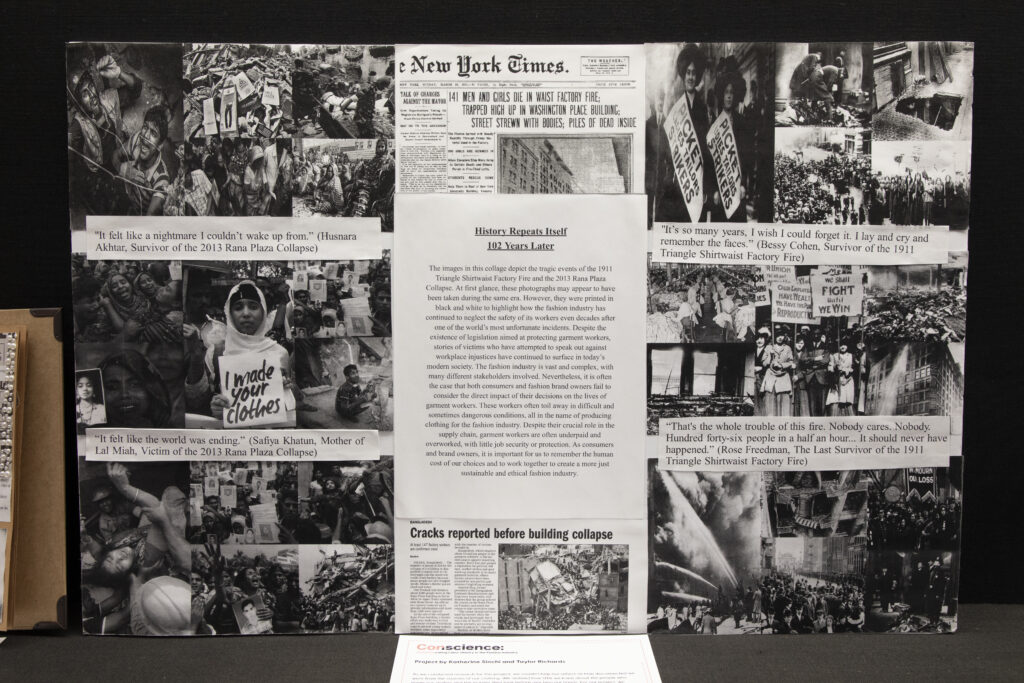
As we conducted research for this project, we couldn’t help but reflect on how disconnected we were from the sources of our clothing. We realized how little we knew about the people who made our clothes and the journey they took before reaching our hands. For our project, we decided to create a collage that showcased the heartbreaking events of the 1911 Triangle Shirtwaist Factory Fire and the 2013 Rana Plaza collapse. We aimed to provide a thought-provoking visual representation and emphasize the lack of care and respect for garment workers. And also to encourage others to reflect on their consumption and purchase decisions. We interviewed a fashion professional from Vancouver who has been a design intern at Oak & Fort, a social media assistant and an inventory associate for Aritzia. She had no knowledge about the 1911 Triangle factory fire or any of the recent tragedies. She was struck by the eerieness of these repetitive tragedies.
Project by Kathie Munoz, Jahnai Wade, Talia Eshtiaghpour
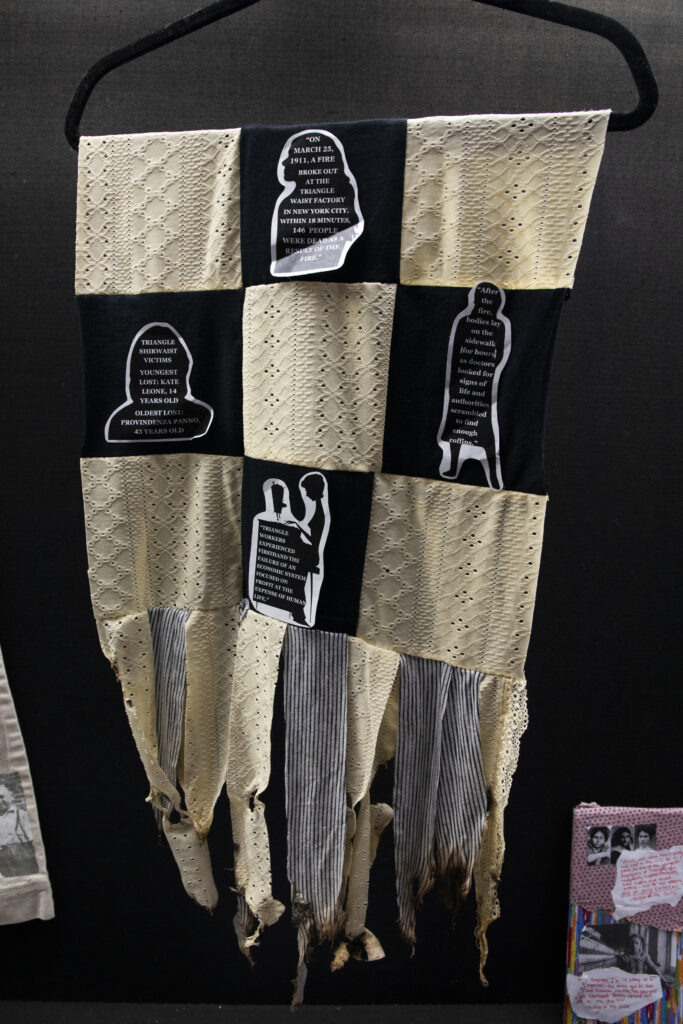
For our creative project we decided to make a quilt with quotes in representation of the Triangle Shirtwaist Factory and the Rana Plaza Fire. The idea for our project stemmed from all the garment workers who passed away in the fires, and the garments that those women made resulted in their own deaths. For our creative visual representation we wanted to use fabrics from fast fashion brands, thankfully Kathie was able to help us elevate this idea by sewing together a quilt out of these fabrics. The handmade quilt is the medium that holds quotations that are the textual evidence of the history. We also wanted to burn the edges of the quilt to add intensity and represent the disposable labor. When it was time to start burning the strips a new problem arose– the fire that erupted from a small strip of cotton fabric was frightening, it put a lot into perspective for me. We could not imagine being trapped in a workroom with dry wicker baskets full of cotton shirtwaists, the speed at which this fire must have spread across the room must have been horrific. It’s a miracle there were any survivors at all.
Project by Alexis Paul, Hannah Eigsti, and Finley Dunn
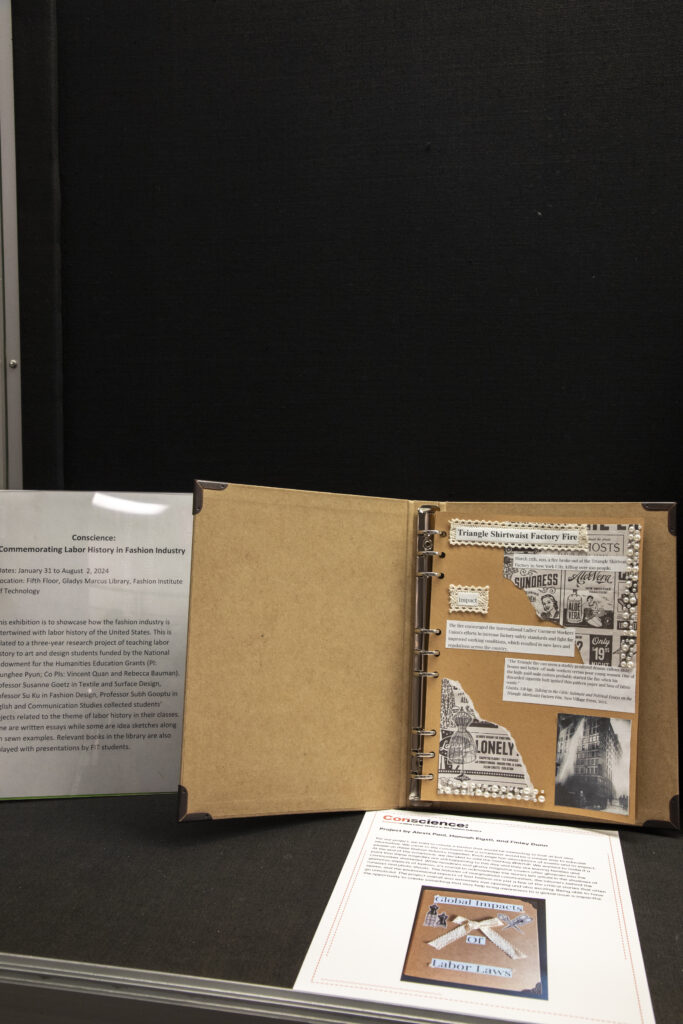
For our project, we tried to create a format that would be interesting to look at but also informative. We came to the conclusion that a scrapbook would be a unique way to educate people on these fashion industry tragedies. Each page has descriptions of events and its impact. At the end of the scrapbook, we decided to add the hashtag #PAYUP. We wanted to make it a point that these tragedies are still happening to this day and they are leaving families and communities shattered. While headlines and glossy magazine covers offer glimpses into the glamorous aspects of fashion, it’s crucial to acknowledge the stories left untold in the shadows of runways and photo shoots. The histories of marginalized communities, the laborers behind the seams, and the environmental impacts of fast fashion are just a few of the critical stories that often go unnoticed. The project overall was extremely eye opening and also exciting. Being able to have the opportunity to create something that may help bring awareness to a global issue is impactful.

